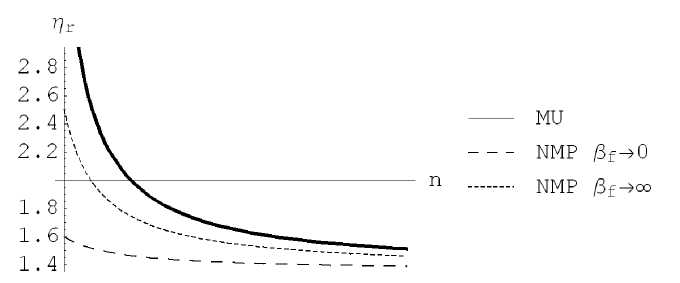wage settlement but increases the demand of firms for cheaper labor. In such a case,
a competition effect would discourage wage aggressiveness to a larger extent since by
assumption is higher than the adverse output (Figures 5).
Finally Figure 6 illustrates the case in which the adverse output effect prevails in a MU
but not under a NMP regime. If the monetary unification induces to higher centralization
at the union-wide level, macroeconomic performance improves.

Figure 4: Labor demand elasticity and CWS when the adverse output effect prevails and
^hh = Vu = θ∙
The results in this section are in sharp contrast with the U-shaped curve à la Calmfors
and Driffill (1988). In order to have the U-shaped relationship between the CWS and
economic performance three assumptions have to be satisfied41:
(a) There exists a monotonic relation between the CWS and the internalization effect.
(b) An increase in CWS always reduces competition in the labor market.
(c) In a decentralized wage setting the competition effect prevails on the internaliza-
tion one, while under a centralized wage setting is the internalization effect to be
dominant.
Condition (a) always holds in our model, while (b) is met only if the adverse output
effect is smaller than the adverse competition one. The union i’s labor demand elasticity
with respect to her wage is an indicator of the degree of competitiveness in the labor mar-
ket: an elastic labor demand shrinks monopoly power in the labor market. As said before,
this elasticity can be increasing or decreasing in the CWS. However, the third assump-
tion (c) is never satisfied since with atomistic wage setters (i.e. monopolistic competition,
пн → ∞) the labor demand elasticity converges to σ.
41These conditions are pointed out in Guzzo and Velasco (1999).
23
More intriguing information
1. Measuring Semantic Similarity by Latent Relational Analysis2. Estimation of marginal abatement costs for undesirable outputs in India's power generation sector: An output distance function approach.
3. The name is absent
4. Labour Market Flexibility and Regional Unemployment Rate Dynamics: Spain (1980-1995)
5. The name is absent
6. The name is absent
7. Uncertain Productivity Growth and the Choice between FDI and Export
8. The name is absent
9. Public infrastructure capital, scale economies and returns to variety
10. The name is absent